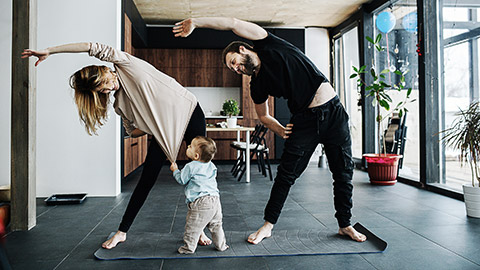It is important to understand our own emotions. There isn’t a ‘one size fits all’ for emotions and how we respond to them. If we understand our emotions, we can understand how these emotions will affect us and what response we might have. This allows us to prepare ourselves or remove ourselves from a situation where our response may not be socially acceptable or cause conflict.
Emotional thinking is the range of emotions we possess, both negative and positive, as well as how we physically, psychologically, and cognitively react to everyday activities.
| Examples of: Negative emotions |
Examples of: Positive Emotions |
|||
|
Anger Sadness Fear Disgust Grief Resentment Outrage Contempt |
Happiness Enjoyment Love Surprise Kindness Thrill Wonder Excitement |
Emotions can be recognised by their impact on our cognition. For example:
- Jumping to a conclusion – reaching a conclusion without all the information
- Black and white thinking – being inflexible and unforgiving. We only look at the black and white and ignore anything that falls into the grey area.
- Paranoid thinking – we feel vulnerable and often become paranoid.
- Catastrophizing – overreaction fuelled by intense emotion
- Irrational – ignoring reason and making decisions without due consideration
- Emotional judgement – judgments made too quickly which are based on feelings rather than facts.
Self-compassion
Self-compassion is a healing process. It is when we treat ourselves with kindness, understanding and acceptance when we face difficulties, failures, or flaws.
There are three elements of self-compassion. These include:
Having self-compassion means to be warm and understanding towards ourselves when we face failure, feel inadequate or are suffering, rather than ignoring the pain we feel or coming down on ourselves with self-criticism. In order to be self-compassionate, we need to recognise that being imperfect, failing or experiencing difficulties are just a part of life. We need to be gentle on ourselves throughout these situations and not become angry. Instead of denying or fighting reality, we need to accept it with sympathy and kindness. This will lead to us being more emotionally steady.
Frustration at reality and at the idea of things not being exactly how you want them is often accompanied by irrational but pervasive sense of isolation. All humans suffer, not one person is the only person suffering or making mistakes and we need to accept that. Self-compassion involves this understanding and recognising that suffering and personal inadequacy is a shared experience by all humans. It is something that we all go through, rather than just something you are experiencing.
Self-compassion requires a balanced approached to emotions, especially those negative emotions, so that we don’t suppress or exaggerate our feelings. Mindfulness is a mental state of being aware and present in the moment. When we are mindful, we accept our thoughts and emotions without judgement or suppressing them. Whereas over identification is when we become overly attached and absorbed one’s negative reactions. We concentrate on our failures, imperfections, and limitations.
We cannot ignore our pain and feel compassion at the same time.
If we are mindful, we can prevent over identification from occurring.

Physical health & Exercise
Physical health is important for your physical wellbeing as well as your mental health. Here are some ways to improve your physical health:
- Start exercising
- Get enough sleep
- Hydrate
- Balanced and nutritious diet
- Reduce your sugar intake
- Vitamin D – Get outside in the sun!
- Complete mentally stimulating activities such as reading or solving a puzzle
- Preventative measures such as dental work or getting your eyes checked
- Wash your hands
- Keep stress in check
Regular exercise can benefit not only your physical health but your mental health too. Exercise causes the release of endorphins and serotonin. These are ‘feel good’ chemicals that help improve your mood.
The benefits of physical activity include:
- Boost in self esteem
- Boost in memory
- Reduce stress
- Reduce mental health conditions such as anxiety and depression
- Help with the recovery of mental conditions such as anxiety and depression
- Reduce feelings of loneliness and isolation
- Improve sleep
- Improve concentration
- Increased energy
Exercising can sometimes seem like a chore. Find something that you really love to do. Exercising doesn’t have to be working out in a gym, it could be going for a walk around the local river, a bushwalk, yoga, dancing, boxing, skipping or swimming laps at the pools.
Here is an example of a yoga session you could do in 20 minutes!
Diet & nutrition
A healthy diet is linked to a reduced risk of depression as well as a reduction in symptoms associated with depression and mental health disorders. It is important to eat a balanced diet, drink water and reduce intake of alcohol and caffeine. Some foods, alcohol and caffeine can also be contraindicated with some medicines that may be prescribed to treat mental health disorders.

Not only does eating healthy reduce symptoms associated with mental health disorders but also reduces the chances of getting diseases such as diabetes and obesity. Diseases such as these can affect mental health.

Drinking enough water is also extremely important. Any degree of dehydration can make an individual irritable and therefore affect one’s mental health.
Alcohol is a depressant. Drinking excessive amounts of alcohol can affect your mental and physical health. There are short-term and long-term effects to your mental health. These include:
- Short term – Binge drinking can lead to an impairment of judgement or could result in you deliberately harming yourself.
- Long-term – Alcohol increases the risk of depression and anxiety. It can lead to addiction and dependence of alcohol. It can also increase the risk of suicide.

Caffeine on the other hand is a stimulant. Caffeine can be found in products such as coffee, some teas, chocolate, and energy drinks.
Although there can be some positive effects of caffeine, such as reducing inflammation on the brain caused by depression, it can also have negative effects. Caffeine can become addictive and therefore relied on. Caffeine can affect your ability to sleep and stay asleep which in turn affects your mental health.
So, how can we improve our eating habits?
- Take small steps. You don’t need to make changes overnight.
- Aim to make small changes rather than large changes. This could be as simple as changing from white bread to multigrain bread or using coconut oil instead of other oils.
- Be mindful when eating. Concentrate on eating rather than being distracted by something such as watching tv. Being distracted can lead to overeating.
- Meal prep. Pick a day and cook up some healthy meal options. This means you don’t need to cook every day.
- Speak to a nutritionist.
Mindfulness

Mindfulness is a mental state of mind where you focus on the present. In this state you are completely aware of your surroundings and paying full attention to your feelings and 5 senses – taste, smell, touch, sight and sound.
Benefits of mindfulness include:
- Being present in the moment
- Focusing on the task at hand
- Reduce stress
- Reduce anxiety
- Enhance relationships
- Help manage mental disorders such as depression and aggression
- Improves sleep
- Highlight positive moments
- Improve concentration
So, if we think about the definition, anything can be done in a state of mindfulness. But here are some relaxing activities that allow you to stop thinking about everything else and just focus on the activity at hand:
- Meditation
- Colouring in or painting
- Breathing activities
- Eat mindfully without distraction
- Yoga
- Gardening
Gratitude is being thankful and showing appreciation. When we feel gratitude, we are grateful for someone or something. As humans, we respond to gratitude with kindness, warmth, and generosity.
Gratitude is a spontaneous emotion that we feel in the moment. Examples of gratitude or being grateful include:
- Thinking about the things you are grateful for in life
- Stopping to take in and acknowledge something or someone beautiful you have encountered
- Being thankful for something or something – for example; being thankful for your health, for your job or for your children
- Acts of kindness for people you appreciate in your life
- Gives prayers of thanks
- Meditation
There are three types of gratitude:
- Affective trait
- Mood
- Emotion
Affective trait
This is a person’s general disposition. Some people experience gratitude more frequently than others, however there is a connection between feeling gratitude and those that are conscientious, agreeable and extroverted.
Mood
This is when we experience periods of feeling more grateful then usual. The mood fluctuates over time.
Emotion
This is the feeling of gratitude in the moment. This is a brief experience of gratitude.
Benefits of gratitude:
- Improved sleep
- Better immunity
- Increase happiness
- Decreased stress
- Lower blood pressure
- Reduce symptoms associated with anxiety and depression
- Strong relationships
- Higher self-esteem
- Optimistic

Some simple ways to practice gratitude include:
- Focus on the things you do have and not what you don’t have
- Tell someone in your life that you appreciate them
- Keep a gratitude general
Work-life balance refers to the juggle between work life and home life. It is about managing the demands of you career, your study, your family and personal life.
It is important that we have clear lines between work time and home time. Sometimes these lines can be blurred, especially if you work casually or from home.
A good work-life balance is having a happy and productive day at work and then coming home to family or personal time that is also a positive experience. If we don’t have a good work-life balanced, we become overwhelmed and stressed easily. We also might feel like we are rushing tasks and left feeling like we aren’t doing a good job.
Effects of poor work-life balance:
- Increased stress
- Increased fatigue
- Unsafe working environment
- Reduced amount of time for family and home life
- Decrease in social life
- No time for ‘me time’ such as exercising or mindfulness
- Rushing
- Left feeling unsatisfied or as though you aren’t doing a good job at either work or home
- Burnout
- Increased sick leave
Benefits of a good work-life balance:
- Feeling of satisfaction at work and home
- Having enough time for all aspects of life
- Decreased stress
- Increased concentration and motivation
Ways to improve your work-life balance:
- Know your values
- Practice time management
- Set boundaries
- Enjoy your work
- Review your finances
- Nuture relationships
- Focus on your health
- Have down time
Know your values
What is important to you in life? What aspects of life need to be prioritised? What are your hobbies and interests? Have a think about these things, determine what you values are and don’t budge on these areas
Practice time management
Use methods to track your time. This could be a to-do list, a calendar or you might use an app. Reviewing this frequently can help you see what is chewing up way too much of your time or what isn’t getting any time at all. This will allow you to make changes to your schedule in order to make time for the things that are being neglected.
Set boundaries

Have clear lines between work and home life. We often have access to work on all devices. We can be contacted even when we aren’t at work. If it is important for you to have apps like Teams or Outlook on your phone, make sure you sign out or silence notifications once you have left work for the day.
Pre-plan your days or weeks to set aside time for other activities outside of work.
Enjoy your work
Work can be stressful and overwhelming. This can be normal, but this should not make you hate your job and it shouldn’t be ‘okay’ to continue to work in a job that you hate. If this is how you are feeling, then it might be time to start looking for something else.
If looking for something else isn’t an option, then you might like to discuss options with your current employer. You can ask for some flexible working arrangements including some work from home days or you could look into current job opportunities within your current workplace.
Review your finances
Fewer work hours means more time for yourself and your home priorities. Have a look at your current outgoings and see if there are changes you can make to reduce the amount of money needed. You might be able to make small changes like bringing your lunch from home instead of buying it or maybe you can look at buying things second hand instead of brand new.
Nuture relationships

Prioritise time with your family and loved ones to help build strong and nurturing relationships. Having these relationships or a support system in place will lead to more resilience and help you cope with stress.
Focus on your health
Prioritise the things that are going to lead to better health. This includes physical exercise, getting enough sleep, eating nutritious meals and avoiding things like drugs and alcohol.
Have down time
You need to make sure you have time to switch off and reset. Choose activities you enjoy or that help you recharge your batteries and make time to do them each week.
Work planning

Work planning is a plan of attack to achieve goals. This could be done as an individual or as a group completing a project. A work plan will keep you organised, clearly identify deliverables, and help you effectively plan your days or weeks.
When using a workplace, it is important to make sure everybody involved has access or a copy of the plan. Regular team catch ups will help identify if the work is on track and allow you to update the work plan if required.
A traditional or agile project management style can be used depending on your needs and your management style.
Work plans can be used for the purposes of professional work, academic & personal life
How to develop a work plan:
- Idenitfy the purpose of the plan
Determine the purpose and consider any timelines or deadlines you may have. - Write an introduction and background. (For professional work plans only)
This provides information to your supervisor or manager. This information puts your plan or project into context for them.
- Determine your goals and objectives
These are the things you would like to accomplish. - Consider ordering your work plan by SMART objectives:
- List your resources
You need to list everything you will need to complete the work plan. This includes the financial budget, any stakeholders, rooms, offices and any material objects like internet, journals or newspapers.
Human connection and social relationships improve emotional wellbeing and physical health. However, difficult relationships can be stressful and increases the risk of anxiety, depression and has a negative effect on one’s physical health.
Characteristics of a toxic relationship include:
- The feeling of being burned out or depleted after a social encounter or interactions
- Having negative thoughts about the relationship
- Imbalance of give and take
- Lack of respect or feeling valued
A simple and effective way to build positive social relationships is by showing appreciation and recognising when our friends or work colleagues go out of their way to do something for us or to support us.

So, how can we foster positive relationships?
- Be an empathetic listener
- Make sure you are paying attention when the other person is talking to you. Ask questions and engage to show them that you understand what they are saying.
- Share the spotlight
- Don’t make everything about you. If someone is telling you about a problem or something that is going on in their life, support them but don’t turn it back around to be about you and things you are struggling with.
- Stay calm
- We want to make sure that our conversations and interactions are positive and build stronger relationships rather deconstruct the relationship we are trying so hard to maintain. If you find yourself becoming agitated or like you cannot be calm, take a break and come back to the conversation later.
- Interact in person
- Reduce time on social media and increase face to face exposure. We often say things via written communication that we may not say to someone’s face. This leads to arguments escalating, creating conflict.
- Emphasise the positive
- Establish boundaries
- Relationships can be draining, especially if one party continuously needs emotional support. Emotional burnout can happen in these relationships. It is important to set limits and boundaries. For example, if you find that one friend calls you a lot to complain or discuss things they are struggling with, make time for these calls instead of always jumping to get the phone call straight away. If you find that face to face interactions is also draining, you might set a limit on how many times a week you see this person, or maybe you can schedule activities that are active and don’t leave room for a lot of face-to-face communication.
- Prioritise your own wellbeing
- This is about making time for yourself away from work, away from family and away from kids. Its ‘you’ time. It is important to make time for yourself and to get help from family or hire help to make sure you have ‘you’ time away from the kids. This helps you reset and recharge.
- Communication
- It is important to open the lines of communication. It is equally important to talk about the positive as it is to talk about the negative. If there are problems within a relationship it is important that you discuss these issues and come to a resolution. If we don’t communicate about these things, we can become anxious about addressing it or meeting the person.
Sometimes it may not be conflict with the person directly but rather a difference in opinion. If you cannot discuss the topic civilly then it may be best to set boundaries around such topics and agree not to discuss it further. It is okay not to agree on everything but it is important that your relationship doesn’t become toxic because you continue to argue about a topic.
Counselling

Counselling is a service provided by a counsellor. A counsellor is a mental health professional. You can access a counsellor to talk about any difficulties or struggles you may be facing in life and they will help you overcome these.
A counsellor will assist you in solving problems and assist you in developing problem-solving skills. Counsellors can assist you with issues such as:
- Relationships
- Money or financial distress
- Grief and loss
- Some traumas or traumatic events
- Stress
- Bereavement
- Mental health illness such as depression and anxiety
- Post natal depression
- Anger management
- Drug and alcohol abuse
Health care professionals that can provide counselling include:
- Counsellors
- GPs
- Mental health nurses
- Mental health social workers
- Clinical psychologists
- Psychologists
- Psychiatrists
You can ask your GP for a referral to a service, or you can use this tool to find a provider near you – Find a health service | healthdirect
The helplines and services below are available 24 hours, 7 days a week.
- Lifeline (anyone having a personal crisis) — call 13 11 14 or chat online
- Suicide Call Back Service (anyone thinking about suicide) — call 1300 659 467
- Beyond Blue (anyone feeling depressed or anxious) — call 1300 22 4636 or chat online
- MensLine Australia (free telephone and online counselling service) — call 1300 78 99 78
- KidsHelpline (free confidential online and phone counselling service for young people 5 to 25) — call 1 1800 55 1800 or web chat online
Personal therapy

Personal therapy is a type of counselling. It is the therapeutic process of sharing your experiences, difficulties and/or struggles with mental health professional.
The goal of person therapy or personal counselling is to develop personal coping skills, to stimulate personal growth and improve your overall mental health.
Personal therapy provides individuals with a safe space to vent and discuss all their issues or struggles. Talking these through with a mental health professional will also help you better understand your feelings and how to cope with them.
Personal therapy will assist you to:
- Add to your support network
- Gain a better understanding of yourself
- Learn how to handle emotions
- Identify underlying causes of symptoms
- Provide coping strategies
- Manage symptoms
- Facilitate lifestyle changes
These services are confidential.
Personal therapy would be beneficial to anyone that is:
- Experiencing extreme emotions
- Experienced trauma or loss
- Struggling with substance abuse
- Experiencing problems at work
- Has lost enjoyment or happiness
- Has strained relationships
- Has concerns about family or friends
Debriefing
Debriefing is a simple yet powerful tool. Debriefing allows you to:
- Self-correct
- Build relationships
- Work effectively as a team
- Improve individual and team performance
- Openly discuss areas for improvement
- Openly discuss things that may have been traumatic and out of the usual for your work environment
What involved in debriefing?
This is generally a team meeting or huddle. It does not have to be formal and occasionally will happen straight after an event. If a supervisor or manager is not present, a senior team member can lead the discussion. This should be a safe place where everyone can contribute.
There are 3 steps to debriefing.
Step one – The What
This is when you review the activity or event that has occurred. What happened? What did you observe? This can be a lead discussion by your manager, supervisor, or senior staff member.
Step two - The so What
This is when you look at the details and the significance of the activity or event to gain further insight. How was your communication? What contributed to your team’s success? What role did individuals play in the activity or event?
Step three - The What now
This is when you discuss what you have learnt and how you can build on from what you have learnt from the activity or event. This will help you and your team in the future. What worked well? What didn’t work well?
Develop your own Self-Care plan. Use this additional resource to help you build a Self-Care plan.
Additional resource:
How to Create Your Own Self-Care Plan - Mental Health First Aid
